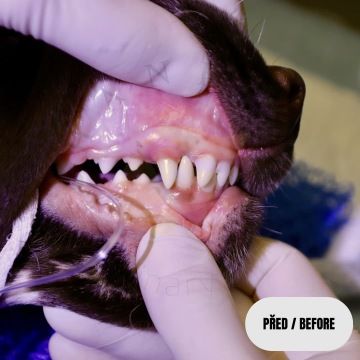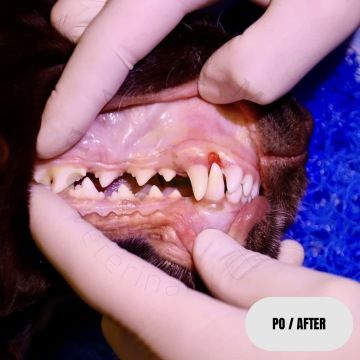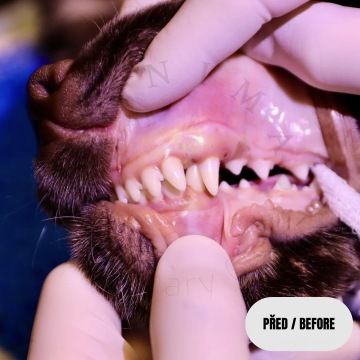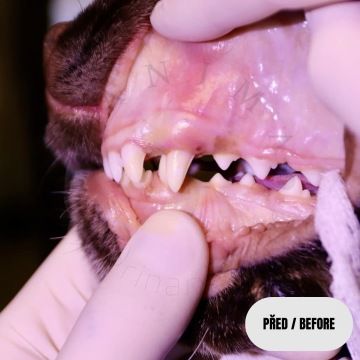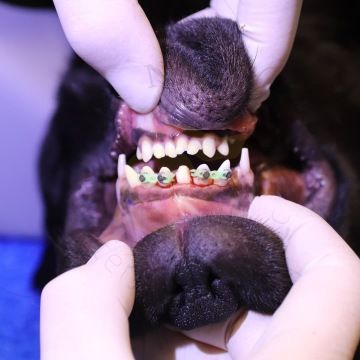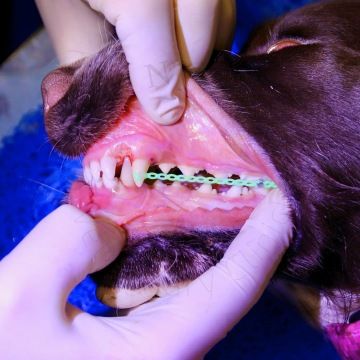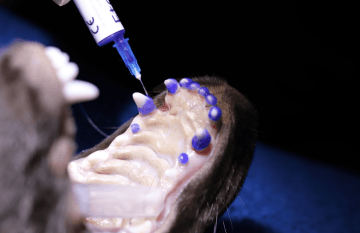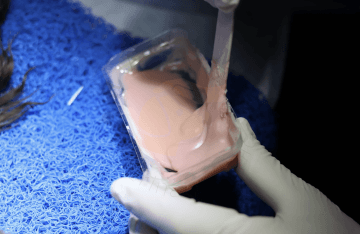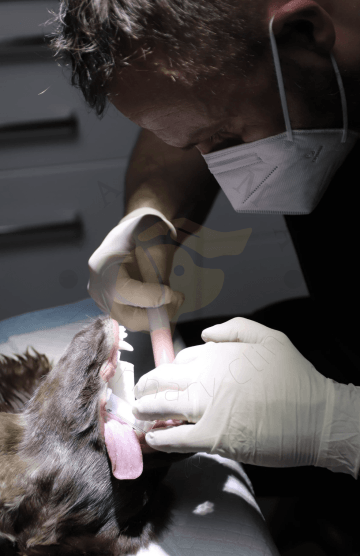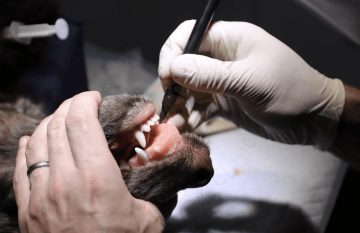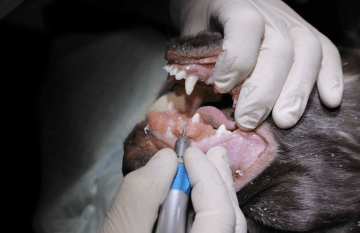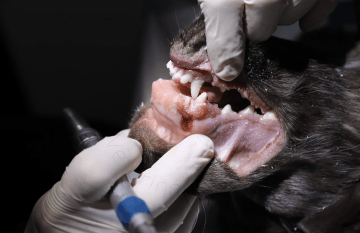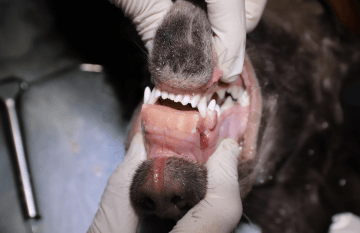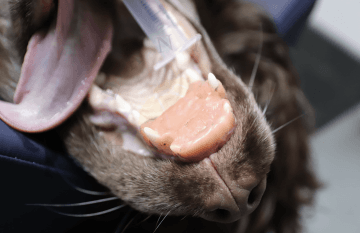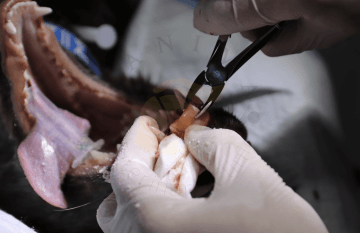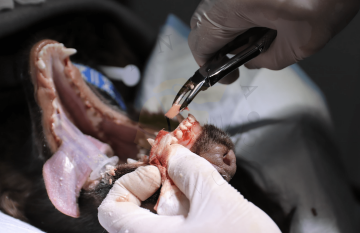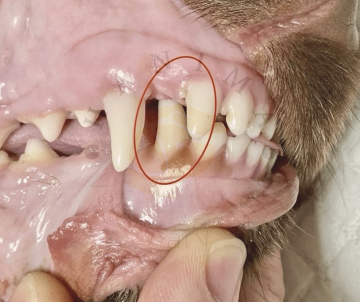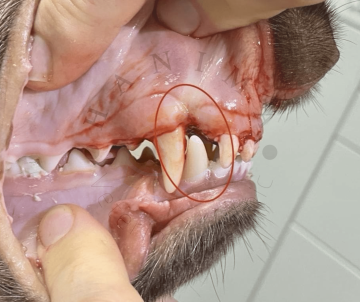Orthodontics
Professional Dental Consultation
The first step before any dental procedure with us is always a professional dental consultation, also known as a dental examination. Without this, we are unable to determine the type, extent, or cost of the necessary dental or dental surgical procedure. We strive to approach our clients transparently to ensure that it is entirely clear what needs to be done and how much it will cost.
The price for a professional dental consultation is 940 CZK.
Puppies normally have twenty-eight baby (baby) teeth that erupt within the first six months of life, and adult dogs have forty-two permanent (adult) teeth. Dogs have four types of teeth:
Incisors are teeth located between the canines on the upper and lower jaw. They are used to grasp food and, together with the lower canines, help to keep the tongue in the mouth.
The canines are located on the sides of the incisors and are used to grasp food and other objects.
Premolars are located behind the canines in both the upper and lower jaws and help grind food.
The molars are behind the premolars and are the teeth in the back of the mouth. Used to grind food before swallowing.
What does occlusion mean?
Occlusion is a term used to describe the way the teeth are positioned in relation to each other. "Normal" occlusion occurs when the upper incisors closely overlap the lower incisors (scissor bite), when the lower canines are equidistant between the upper third incisors and the upper canines, and when the tops of the mandibular premolar crowns are between the maxillary premolar spaces.
There are exceptions, namely breeds with "short noses" (brachycephalic dogs) such as boxers, shih-tzus, Boston terriers and lhasa apsos. In them, an "abnormal" bite is considered "normal" for the breed, and the lower jaw protrudes in front of the upper jaw, changing the aforementioned relationships between the teeth.
What is a malocclusion?
Malocclusion refers to the abnormal position (alignment) of the teeth. There are two types of malocclusion:
skeletal (skeletal) - malocclusion occurs when the abnormal length of the upper or lower jaw causes the teeth to be misaligned
alveolar (dental) - the length of the upper and lower jaws are normal, but there may be one or more teeth that are out of normal alignment (malpositioned tooth/teeth)
When skeletal or alveolar malocclusion causes trauma to other teeth or soft tissues of the oral cavity and subsequent pain in the animal, treatment is necessary. Therapy options include:
extraction - pulling out the tooth causing the problem
moving the affected tooth or other teeth so that they do not interfere with each other
surgically creating space for a misplaced tooth
What are some common forms of skeletal malocclusion?
Mandibular dystocclusion or class 2 malocclusion (MAL 2)
Also known as underbite or mandibular brachygnathism. It occurs when the lower jaw is shorter relative to the length of the upper jaw. When the mouth is closed, the teeth of the lower jaw are not in occlusion (in a normal position relative to each other) with the corresponding teeth in the upper jaw. When the mouth is closed, there is a space between the upper and lower incisors, and the lower incisors can traumatically injure the hard palate behind the upper incisors. The upper premolars are positioned too rostrally (toward the nose) compared to their lower jaw counterparts.
Mandibular interocclusion or class 3 malocclusion (MAL3)
Also known as an overbite, reverse scissor bite, or mandibular prognathism. It occurs when the lower jaw is longer relative to the upper jaw and the lower teeth protrude in front of the corresponding upper teeth. If the difference in jaw length is minimal, then the upper and lower incisors can touch each other edge to edge, resulting in an occlusion known as pincer bite.
Maxillomandibular asymmetry
Asymmetry can occur in many different ways. It is important to remember that the upper jaw and lower jaw are folded in pairs, i.e. from the left and right sides. All these 4 parts of the jaw grow independently and that is why asymmetry can occur in different directions.
rostrocaudal asymmetry - length asymmetry between the left and right sides on the same jaw; in most cases the opposite side is in normal occlusion
side to side asymmetry - deviation from the center line in the upper or lower jaw
dorsoventral asymmetry (open bite) - an abnormal (enlarged) space between the upper and lower jaw (can affect one or both sides) and is referred to as an open bite
What are some common forms of alveolar malocclusion?
Rostral crossbite
This occurs when the canines and premolars on both sides of the mouth are in occlusion (set up correctly), but one or more lower incisors are positioned in front of the upper incisors when the mouth is closed.
Caudal crossbite
This occurs when one or more premolars or molars (the teeth behind the canines) of the lower jaw are positioned towards the face (outwards) than the opposing upper teeth when the mouth is closed.
Linguovert mandibular canines
Also known as lingually displaced canines or narrow canines. This malocclusion refers to a situation where the lower canine (one or both can be affected) is bent inwards. The linguoverted canine is then often in traumatic contact with the hard floor of the mouth. This condition is often caused by persistent deciduous canines and can usually be corrected with various options such as a bite ball, crown shortening, gingivoplasty, bite plate, or extraction.
Mesioversal maxillary canines (lanceolate canines)
This defect may be genetic (typical of the Sheltie breed) or may develop secondary to persistent baby teeth. . In this case, the upper canines are "laid" horizontally and shifted rostrally (toward the nose). The space between the upper canine and the extreme upper incisor, where the lower canine is located during normal occlusion, disappears, which subsequently causes tissue trauma and pain. In our clinic, we use the traction chain method in combination with cortical screws to move the upper lanceolate canines into a physiological position.
Treatment of Malocclusion
When skeletal or alveolar malocclusion causes trauma to other teeth or the soft tissues of the oral cavity, resulting in pain for the animal, treatment is necessary. The most common therapeutic methods include:
Orthodontic appliances: The use of various types of orthodontic appliances, such as bite plates, which help correct improper tooth alignment by gradually moving the teeth into the correct position.
Tooth extraction: In some cases, it may be necessary to remove teeth that are causing problems or pain to improve overall tooth alignment and facilitate healing.
Surgical procedures: For skeletal malocclusions, surgical intervention may be required to adjust the jaws and ensure proper tooth alignment.
Conservative treatment: In milder cases, monitoring and regular check-ups may be recommended to ensure the problem does not worsen. We utilize special "bite balls."

